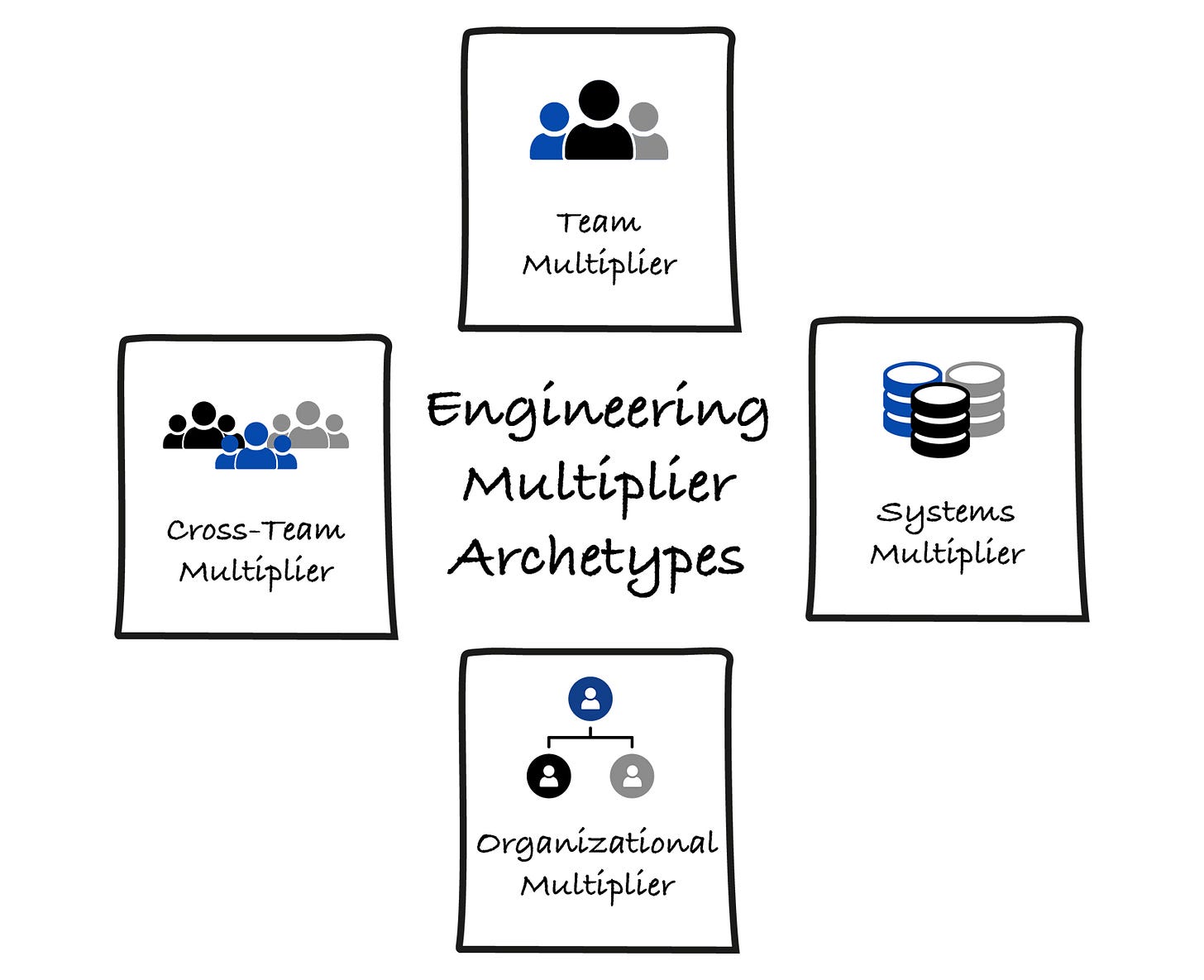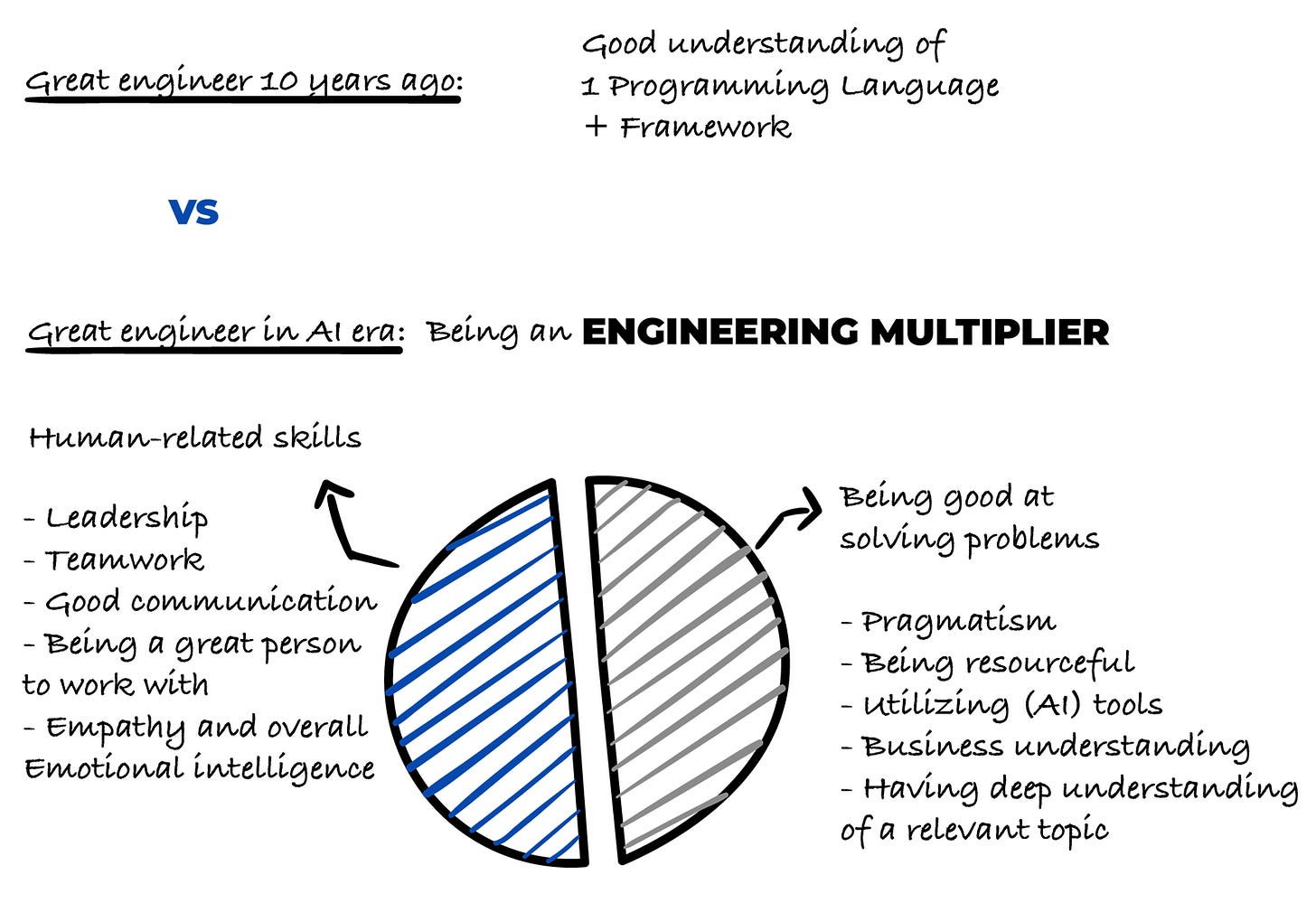Engineering Multiplier Archetypes
4 main Archetypes, where each of these makes a big impact in its own specific way!
Intro
In today’s AI era, being a great engineer is no longer defined by your individual contribution alone.
Being a great engineer is defined by the ability to make others around you better, to deliver projects successfully, and to create impact that moves the whole organization forward.
There are many ways to multiply your efforts:
Making your whole team better,
To work well across different teams,
Be a multiplier through systems,
Multiply and scale through people.
These are all archetypes of multipliers, where each provides immense impact in its own specific way. And we’ll go through each in this article.
This is an article for paid subscribers, and here is the full index:
- What Actually is an Engineering Multiplier?
- It’s Becoming More and More Important For Engineers to Become Multipliers in the AI Era
- Different Ways to Multiply Your Effort → Engineering Multiplier Archetypes
- No Matter if You are a Junior, Mid-Level, or Senior Engineer, You Can and Should Become a Multiplier
- The Team Multiplier
🔒 The Cross-Team Multiplier
🔒 The Systems Multiplier
🔒 The Organizational Multiplier
🔒 Last words
Let’s start!
What Actually is an Engineering Multiplier?
Before we go to the specifics of each type of engineering multiplier, I want to ensure that it’s very clear what an engineering multiplier is.
I like the term “Engineering Multiplier” because it’s a mix of “Engineering” and “Force Multiplier”, which fundamentally connects the two together.
Being an engineering multiplier means being someone who amplifies the productivity and effectiveness of the engineers around them, not just focusing on their own output, but elevating the entire team and the organization.
An engineering multiplier doesn’t just ask, “What can I build?”, they ask, “How can I make everyone around me more effective?”.
Now, let’s talk about how important being a multiplier is.
It’s Becoming More and More Important For Engineers to Become Multipliers in the AI Era
This is what I already mentioned in this article:
As tools for development have gotten better, the desired skills for engineers have moved from just pure knowing programming languages and frameworks (expected) to problem-solving abilities and people skills.
It’s less about the tasks, but how big an impact you can create. And engineers who can create the biggest impact have the multiplier mindset.
It’s the mindset where you focus less on just your pure individual tasks, but you focus on how you can make things better for your whole team, organization, and, of course, the customers (users).
Now, let’s get into the specifics of different archetypes of multipliers.
Different Ways to Multiply Your Effort → Engineering Multiplier Archetypes
There are 4 main types of multipliers:
The Team Multiplier
They multiply their efforts through actions specifically targeted to help everyone on the team become more productive and effective.
Roles mostly associated with this archetype: Tech Lead, Team Lead.
The Cross-Team Multiplier
They work well across multiple teams by expanding their influence beyond a single team and drive technical strategy forward by creating great documentation, guidelines & styleguides and sharing their knowledge.
Roles mostly associated with this archetype: Staff Engineer, Principal Engineer.
The Systems Multiplier
They thrive in designing systems, defining the architecture, and processes that enable entire teams and organizations to move faster and more cohesively.
Roles mostly associated with this archetype: Architects.
The Organizational Multiplier
They focus on amplifying people, their impact, speed, and cohesion through intentional leadership, good processes, and organizational alignment.
Roles mostly associated with this archetype: Engineering Manager, Director of Engineering, or VP of Engineering.
Now, let’s get into the very important question that many engineers wonder.
No Matter if You are a Junior, Mid-Level, or Senior Engineer, You Can and Should Become a Multiplier
Many engineers wonder whether they need to already be in the role (Tech Lead, Team Lead, Staff, EM, Architect, etc.) to be an engineering multiplier, and my answer?
My answer is a strong NO.
As mentioned above, no matter in which particular stage of your career you are, you are going to be more and more expected to be a multiplier as time goes on.
Just focusing on writing code and working based on clearly defined tasks is what is going to be needed less and less as tools for development get better over time.
As you know, the hardest thing when working with AI is to write a clear input (prompt), and if you can clearly define what you need + include all the context that is needed → you will already get great results working with AI agents to make changes in the codebase.
The work that engineers do is shifting a lot more to good people skills and pure problem-solving abilities, which includes utilizing all the tools available, and also the engineering roles are getting closer together.
So, my advice is to shift your focus toward a certain archetype that resonates the most with you and focus on shifting your efforts in that area.
To help you with this, we will go through all 4 archetypes in detail.
The Team Multiplier
If you are a jr, mid, or sr. Engineer, this would be my recommendation as the first way of multiplying your efforts.
The main question you are asking yourself is: “How can I make my whole team better?” and “What’s going to be best for the team?”.
Think about what some of the main responsibilities of Tech Leads or Team Leads are. The 2 questions mentioned above are what these 2 roles are focusing on the most.
What does Team Multipliers do? They focus on:
Creating documentation to help the whole team move forward faster.
Helping to onboard new colleagues to the team and help them to be productive as fast as possible, while constantly looking to improve the onboarding process.
Asking the right questions to the right people to ensure that the whole team clearly understands the expectations.
Helping others as much as possible, so their colleagues get unblocked faster and the whole team gets more productive because of it.
Treating code reviews as an opportunity for coaching and mentoring → they review PRs swiftly, and they jump on a call with the fellow engineer if there are more things to change.
Doing pair (mob) programming sessions with other engineers, as they understand how that can help speed up the learning.
Sharing their knowledge regularly with the team (what books, articles, newsletters they have read) and also doing learning sessions.
Being resourceful, so that any problem they come across, they can learn everything that is needed in order to solve it.
These are some of the most important things that Team Multipliers are doing, but there are many more.
The important thing to remember is to do things where your clearly answer YES to the question “Is this going to be best for the team?”.
Now, let’s go to the Cross-Team Multiplier archetype next.






